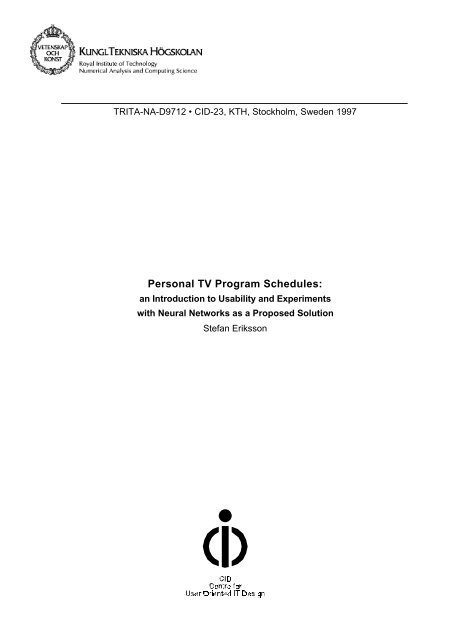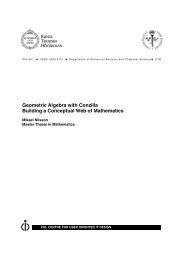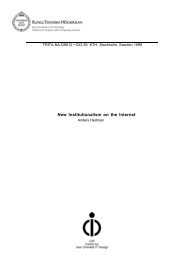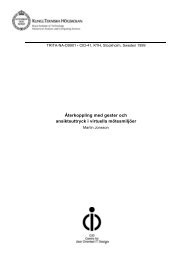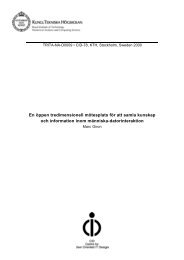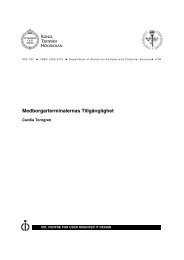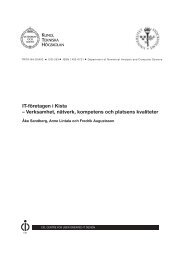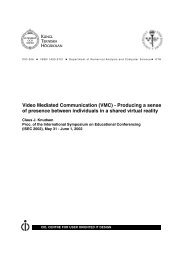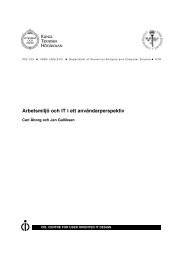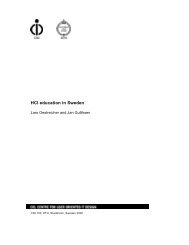5 Personal TV program schedules - CID - KTH
5 Personal TV program schedules - CID - KTH
5 Personal TV program schedules - CID - KTH
Create successful ePaper yourself
Turn your PDF publications into a flip-book with our unique Google optimized e-Paper software.
TRITA-NA-D9712 • <strong>CID</strong>-23, <strong>KTH</strong>, Stockholm, Sweden 1997<strong>Personal</strong> <strong>TV</strong> Program Schedules:an Introduction to Usability and Experimentswith Neural Networks as a Proposed SolutionStefan Eriksson
Stefan Eriksson<strong>Personal</strong> <strong>TV</strong> Program Schedules:an Introduction to Usability and Experimentswith Neural Networks as a Proposed SolutionReport number: TRITA-NA-D9712, <strong>CID</strong>23ISSN number: ISSN 1403-073XPublication date: November 1997E-mail of author: stefan1@e.kth.seURL of author: http://www.e.kth.se/~stefan1/Reports can be ordered from:<strong>CID</strong>, Centre for User Oriented IT DesignNada, Dept. Computing Science<strong>KTH</strong>, Royal Institute of TechnologyS-100 44 Stockhom, Swedentelephone: + 46 8 790 91 00fax: + 46 8 790 90 99e-mail: cid@nada.kth.seURL: http://www.nada.kth.se/cid/
AcknowledgementsThis report is the product of a master’s thesis performed at the Centre for User OrientedIT Design, <strong>CID</strong>, a competence centre at NADA, <strong>KTH</strong>. The thesis project is a part of theresearch area Worlds on Interactive <strong>TV</strong>.Special thanks to Hans Mandorff and Mediamätning i skandinavien AB, MMS. Theyhave provided all necessary data about <strong>TV</strong> viewers used in my experiments.I also wish to thank SVT, <strong>TV</strong>3, <strong>TV</strong>4, Kanal 5, <strong>TV</strong>6 and Z<strong>TV</strong> for their help with <strong>program</strong><strong>schedules</strong>.iv
ContentsPart I Agents, usability and everything1 Introduction..................................................................................................12 What is an agent?.........................................................................................13 What agents can do for <strong>TV</strong> viewers and how............................................24 Agent environment.......................................................................................24.1 The viewer ................................................................................................................24.2 <strong>TV</strong>-<strong>program</strong> information ..........................................................................................35 <strong>Personal</strong> <strong>TV</strong> <strong>program</strong> <strong>schedules</strong>.................................................................45.1 What functions does the viewer need and how is she about to use them? ...............45.2 Mutations, the source of evolution ...........................................................................56 Testing a personal <strong>TV</strong> <strong>program</strong> schedule ..................................................67 Design proposals for a personal <strong>TV</strong> <strong>program</strong> schedule algorithm..........67.1 Chosen design...........................................................................................................7Part II Experiments with neural networks8 Introduction to neural networks ................................................................99 Available test data......................................................................................109.1 Program data...........................................................................................................109.2 Viewer data.............................................................................................................1010 Rating <strong>program</strong> information and <strong>program</strong> name...................................1110.1 The algorithm .........................................................................................................1111 Generation of patterns ..............................................................................1212 Network training........................................................................................1212.1 How to limit the generalization error .....................................................................1313 Network architecture.................................................................................1313.0.1 Input to the network.................................................................................1313.0.2 Hidden neurons........................................................................................1413.0.3 Output ......................................................................................................15v
14 Measuring network performance ............................................................ 1514.1 Calculating the value of a <strong>program</strong> ........................................................................1514.2 Measuring the overall performance........................................................................1715 Results ........................................................................................................ 1916 Discussion................................................................................................... 2017 Conclusion ................................................................................................. 21References18 References .................................................................................................. 2319 Recommended reading ............................................................................. 2320 WWW Home pages................................................................................... 24AppendicesAppendix A Tools ................................................................................................ 25Appendix B About the data from MMS............................................................ 26Appendix C Stuttgart Neural Network Simulator........................................... 26Appendix D Results and figures......................................................................... 27vi
Part I Agents, usability and everything1 IntroductionThe introduction of digital <strong>TV</strong> will reveal hundreds of <strong>TV</strong> channels. The major problemwith all these channels is the lack of tools to help the viewer navigate through theplethora of <strong>program</strong>s. Channel surfers will have problems surfing through all channelsbefore the first channel visited has changed its contents. And there will be little hopefor those obsessed with reading <strong>schedules</strong> for all <strong>program</strong>s available.To help lost and resigned viewers in their search for entertainment and information,personal computer-based so called agents have been proposed as an aid for those whowant to surf above the mud.These agents can be taught viewers’ preferences and habits. Instead of spending hourswith a 50 page <strong>program</strong> schedule, viewers will have their own personal <strong>TV</strong> <strong>program</strong>schedule which will contain only <strong>program</strong>s that are supposed to be interesting to theviewer.A <strong>TV</strong> agent can also be used as a help for the <strong>TV</strong>-set itself and for other services likehome-shopping and various forms of entertainment.This report will focus on personal <strong>TV</strong> <strong>program</strong> <strong>schedules</strong>.2 What is an agent?A lot of hard work is being carried out around the world trying to define what agentsare and what they should do. A very brief explanation could be made by saying that anagent is a system that has some sort of intelligence; that it acts on behalf of someone;has goals that it tries to bring about; has knowledge about its environment; solves problemsthat arise, and works autonomously (Wooldridge & Jennings 1995).An important difference between an agent and a plain <strong>program</strong> is that an agent doesn’talways know how to accomplish its tasks or if they are at all solvable. One cannot besure that data given as input to the agent will be enough for the agent’s level of problemsolving, even if it can be proved to be enough theoretically. For a non agent <strong>program</strong> itis always possible to define a minimum input set that will produce the correct result.The result of an agent isn’t always reproducible. If the agent has made new experiencesit might solve an old problem in a new and more efficient way, with a slightly differentresult. A non agent <strong>program</strong> is fully deterministic and always produces the same resultas long as input remains unchanged.1
The definition of what properties a <strong>program</strong> should have to be called an agent is still asubject of much debate. Nwana (1996) notes:“We have as much chance of agreeing on a consensus definitionfor the word ‘agent’ as AI researchers have on arriving at one for‘artificial intelligence’ itself - nil!”In fact there are nearly as many definitions on what agents are and what their propertiesshould be, as there are active researchers in the area.The distinction between agents and non agents has been made even harder by softwarecompanies that have started to use the term agent for almost any kind of software. If it’snew and hot, lets call it an agent.The disagreements on agent properties might lead to people having expectations onagents, which will not be fulfilled in some systems.3 What agents can do for <strong>TV</strong> viewers and howOne application for a <strong>TV</strong>-agent is to propose interesting <strong>program</strong>s to the viewer. To beable to do that the agent must learn about the viewer and the outside world. How muchinformation can the agent retrieve from the user? Is it reasonable that the agent shouldask the viewer about his opinion on an ongoing <strong>program</strong> every 5th minutes or so? Orshould the agent collect data about the habits of the viewer only by counting theamount of time spent on a <strong>program</strong>? The information gathered might be crucial to thevalue of the proposed <strong>program</strong>s and the usefulness of the agent.An agent can also be used as a guide to the <strong>TV</strong>-set as well as to itself. The agent can betaught the viewer’s skills and adopt menus and the amount of assistance the viewerrequires. If, for example, the viewer moves around in lots of menues without issuingany commands, the agent might give the user a first introductory lesson about how the<strong>TV</strong>-set works.4 Agent environmentThe agent environment is the so called world that the agent inhabits and is bestdescribed divided into two parts, an inaccessible part and an accessible part (Russel &Norvig 1995); the viewer and the <strong>TV</strong>-<strong>program</strong>s respectively.4.1 The viewerThe viewer is inaccessible for an agent in the sense that an agent does not have accessto the viewer’s internal states and feelings. An agent has to build its own model of theviewer by observation and by asking the viewer questions.Collection of information from the viewer can be passive or active. Passive registrationof behaviour means that the agent only observes what the viewer is doing; in reality,which buttons the viewer presses on the remote control. In its most basic way the agentkeeps track of what <strong>program</strong>s the viewer actually watches and how much time is spent2
Agent environmenton each <strong>program</strong>. The agent might get a deeper understanding of the viewer’s emotionalfeelings by studying how often buttons are pressed and in what order. For example,a viewer that does a lot of button wear an tear might be either upset or lively orperhaps in another mode.A problem with passive registration is that the agent does not know if the viewer ispresent or not. The viewer might also be present but not attentive.Having a viewer actively participating in a reasoning or debate about what <strong>program</strong>sare to be preferred is an enormous step forward compared to having just a passiveviewer. A simple way of getting feedback is to have some sort of opinion poll aftereach <strong>program</strong>. The agent could ask questions like, did you enjoy the <strong>program</strong>? and,would you like to see more <strong>program</strong>s like this one in the future?Having access to the viewer’s mind and internal psychological processes is a mostappealing property of a <strong>TV</strong> agent. This would imply that we could always make a perfectprediction of what <strong>TV</strong> <strong>program</strong>s the viewer would choose. It would in fact let usbuild an agent that not only could pick out the most interesting <strong>program</strong>s, but also dothe swapping between channels at the wish of the viewer. Unfortunately (or fortunately)this will not be possible until we have a deeper understanding of how thehuman brain works and how to probe it in order for an agent to get inside informationabout the viewer’s desires and preferences. The viewer’s internal states will howeverremain inaccessible for a long time. The best an agent can do in the meantime is to registerbehaviour and to communicate with the viewer to get a deeper understanding ofher thoughts and desires about <strong>TV</strong> <strong>program</strong>s.4.2 <strong>TV</strong>-<strong>program</strong> informationThe agent has access to the <strong>TV</strong>-<strong>program</strong> information at all times. This means that theagent will not have to keep track of the current states in the <strong>TV</strong>-<strong>program</strong> environmentfor other reasons than to improve access speed. The <strong>program</strong> information is suppliedby the broadcasting companies and is, for digital television, described in the DVB-SI(1996), Digital Video Broadcasting-Service Information, standard.The standard includes information about:• <strong>program</strong> title;• description of contents;• starting time;• <strong>program</strong> lengthIn addition to this information there is also information about parent rating, cost, subtitling,languages, display formats, etc.3
5 <strong>Personal</strong> <strong>TV</strong> <strong>program</strong> <strong>schedules</strong>As the number of <strong>TV</strong> channels increase there is an urgent need for a tool to help viewersto find <strong>program</strong>s that they find interesting. The rest of this report will focus on personal<strong>TV</strong> <strong>program</strong> <strong>schedules</strong>. These can be implemented either as a part of a <strong>TV</strong>-agent,or as a stand alone application.The first thing which comes to mind is perhaps a complex search engine with numerouscontrols and gadgets. However, anyone who has used an search engine for theWorld Wide Web to find information on a topic has most certainly experienced thatwhatever the question formulated, there are always too many pages that fit the query. Italways takes more than one effort to get a good answer. An exhausted viewer that hasjust sat down in her favourite <strong>TV</strong> chair probably does not want to type long search sentenceson a keyboard. Of course, saying that a viewer never wants to do this might be alittle ignorant, but in general most viewers just want to watch <strong>TV</strong> and relax. I expectthat a <strong>TV</strong>-set with lots of exclusive features will only be used by a minority of people;primarily people with some computer experiences.Closely related to the problem of finding interesting <strong>TV</strong> <strong>program</strong>s is News and e-mailfiltering. Kilander (1996) finds three different ways in which typical News filters work:• The filter is <strong>program</strong>med by the user.• The user creates a query which the filter attempts to answer.• The filter is trained from examples given by the user.A <strong>program</strong>mable filter might be powerful but this is not applicable for the average <strong>TV</strong>user; mainly because most people do not have any <strong>program</strong>ming skills.With a query form the viewer can search for specific <strong>program</strong>s. A query form is a valuabletool when viewers have widely changing demands. An agent that tries to learn thebehaviour of a viewer with irregular viewing habits will probably recommend all <strong>program</strong>sor none.A filter that is trained by examples is an appealing thing. By counting the amount oftime spent on a <strong>program</strong> or asking the viewer for an opinion, the agent can probablygather enough information to be able to make good <strong>program</strong> proposals.5.1 What functions does the viewer need and how is she about to usethem?How do viewers get information on what <strong>TV</strong> <strong>program</strong>s are available?Will viewers be prepared to rely on a <strong>TV</strong> agent?What criteria are important for the choice of <strong>TV</strong> <strong>program</strong>s?A small opinion poll was made to reveal the answers to these questions.Eighteen people were asked questions about how they find interesting <strong>program</strong>s andwhat they would expect to get from a personal <strong>program</strong> schedule. This is far too few4
<strong>Personal</strong> <strong>TV</strong> <strong>program</strong> <strong>schedules</strong>people to draw any conclusions from, but serves as an indication of how a viewer mightreason.• 17% (compare with: 13%, Wigren 1990) use text-<strong>TV</strong> as a source for <strong>program</strong> informationand 78% uses printed <strong>schedules</strong>. This might be an indication that printed<strong>schedules</strong> are more easy to use and thus preferred. In order to be used, a <strong>TV</strong> agentmust provide something more valuable than ordinary text-<strong>TV</strong> <strong>program</strong> <strong>schedules</strong>do.• There is a strong positive correlation between the number of hours spent watching a<strong>TV</strong> channel and a viewers opinion about that channel. This is a strong reason to givethe agent information about which channels the viewer watches.• 50% thought that it would be worth the extra work to give a judgement about each<strong>program</strong> watched if that could help the agent to give them better suggestions.• 77% thought that they would use a search function often or sometimes. The highpercentage might be due to the fact that most of the persons asked are students whoare familiar with AltaVista and other search functions.• A question which received many different answers was whether the viewer thoughtthat he or she would have confidence in the agent or still browse through all <strong>schedules</strong>.This will, of course, depend on whether the viewer likes the proposed <strong>program</strong>sor not, but even with a good personal <strong>program</strong> schedule some people stillwant to read about all <strong>program</strong>s.5.2 Mutations, the source of evolutionAn agent that has achieved a broad knowledge about a viewers interests and habits willbe able to present an excellent personal <strong>program</strong> schedule, day after day. However, theschedule will probably look almost the same, day after day. The agent will be verypleased with the result of providing the best schedule ever achieved. This is not necessarilya bad thing, the viewer will most certainly be pleased. But is this really what wewant? Isn’t there a need to widen our horizons, to see new unexplored areas of television?Naturally, the viewer could select another channel. But will the viewer do that? Won’tthe viewer simply stick to a couple of well known channels? What about channel 354or so, will the viewer ever look at that channel?One solution might be a mechanism that at random reorders the rules used to pick <strong>program</strong>s.An attempting idea is to let a personal <strong>TV</strong> agent match its viewer’s watching profileagainst other viewers to find similarities in their viewing habits. When the agent finds aviewer which seams to have the same interests as its owner, it can recommend <strong>program</strong>sthat the other viewer watches.5
6 Testing a personal <strong>TV</strong> <strong>program</strong> scheduleThe main problem with user tests of personal <strong>TV</strong> <strong>program</strong> <strong>schedules</strong> is the largeamount of test time needed. To be able to do experiments with personal <strong>program</strong> <strong>schedules</strong>I realized that I needed either test persons willing to spend a couple of hundred ofhours with their <strong>TV</strong>-set or test data from an external source. I was fortunate to get incontact with Mediamätning i skandinavien AB, MMS, who perform market and vieweropinion polls in media and <strong>TV</strong>. MMS provided me with useful data about the swedishviewers and their <strong>TV</strong> habits.The data from MMS contains information about the seven most widespread Swedishchannels and viewer logs from approximately 1400 people from about 650 households.The viewers’ <strong>TV</strong> habits were registered with an equipment called People Meter. ThePeople Meter is an equipment that is connected to the <strong>TV</strong>-set and registers which channelis on. Who is watching <strong>TV</strong> is also registered. This is done with a special remotecontrol on which each household member has their own button. When a viewer startsor stop watching, he or she presses the appropriate button to inform the People Meterwho is watching <strong>TV</strong>.The People Meter keeps a detailed log for each household member. The log containsinformation about:• the viewer’s: gender and age;• the viewing: <strong>TV</strong>-set, channel, starting time and duration with minutes resolution.See Appendix B for further details about MMS data.7 Design proposals for a personal <strong>TV</strong> <strong>program</strong> schedulealgorithmThe core function for a personal <strong>TV</strong> <strong>program</strong> schedule algorithm is to select a subset ofthe broadcasted <strong>program</strong>s that are likely to be accepted as good by the viewer. This canbe done in a number of different ways. I considered three different ways, namely:1. Statistical methodsStatistical methods are useful for representing information about <strong>TV</strong> viewers’ habits.It is an easy task to count the number of times a viewer has watched a specifictype of <strong>program</strong> at a certain time of day, might well be used. Numerous parameterscan be thought of to be included in a statistical representation.A problem with statistical methods is the large number of properties for <strong>TV</strong> <strong>program</strong>sand their mutual dependencies. For example: The viewer prefers football tonews with a probability of 75%. But if a football game is broadcasted on a differentchannel than the viewer’s favourite sport channel it might not be considered interesting.Then footballs priority over news is dependent on the channel. A viewer’s preferencescan also depend on the time of the day, the <strong>program</strong>s’ participants etc.The agent will have to keep a record of all dependencies, strong or weak.2. Neural network6
Design proposals for a personal <strong>TV</strong> <strong>program</strong> schedule algorithmA neural network has an implicit representation of knowledge. It is not possible tohave a brief look at the network and extract some of its knowledge. A neural networkis self organizing in the meaning that important relations are given a largeamount of the networks capacity while unimportant relations are weakened and inthe end forgotten.The strongest reason for using neural networks is their ability to generalise whenconfronted with new situations.3. Knowledge based artificial intelligenceThough neural networks is a form of artificial intelligence, AI, it is different fromclassical AI due to of its low level representation of knowledge. AI usually refers tohigh level reasoning with explicitly formulated knowledge and reasoning capability.A most difficult matter in AI is to purge knowledge. When is a rule valid and whenshould it be removed? A purging utility with poor performance can remove usefulrules and may let the database grow out of bounds. Another difficulty with AI is thatthe system needs a core set of rules and relations to describe the problem at hand.When dealing with human being it is very difficult to define such a set.7.1 Chosen designI decided to focus on neural networks mainly for three reasons:• A neural network is self organizing. No prior knowledge has to be built in to the network.It requires little prior knowledge about the underlying phenomena at hand.This is especially valuable when dealing with human beings.• A neural network has the ability to generalize from learned examples and solve newproblems.• The human brain is a gigantic neural network. Even if a computer can not simulatethe whole human brain, it is a tempting thought that an artificial neural network willhave a knowledge representation that lies close the human brain.7
Part II Experiments with neural networks8 Introduction to neural networksA neural network is basically described as number of computational nodes organised inlayers. These nodes are called neurons. Every neuron is connected to all neurons in itsneighbouring layers through weighted links. Neurons at the input layer are called inputneurons and neurons at the output layer are called output neurons. The intermediateneurons are called hidden neurons.InputsOutputsThe input to one neuron consists of outputs from the neurons in the preceding layermultiplied with a link weight specific to each connection.Inputx 1x 2x pw k1Activationw k2functionuΣk ϕ(u k ) Outputy kw kpThe output value for a neuron is calculated as:p⎛ ⎞y = ϕ⎜∑w j ⋅ x j ⎟⎝ ⎠j = 1Where ϕ(x) is a limiting function. A commonly used function is the sigmoid function:ϕ()v1= --------------------------------1+exp( – av)10.5ϕ(v)0-10 0 109
This function limits the output to be between zero and one. The variable a is a parameterthat controls the slope of the curve.By changing the weights we can get any desired values on the outputs for a certaininput pattern. Weights can be both positive and negative.Training neural networks is done by changing the link weights. The back-propagationalgorithm is the most popular and widespread learning algorithm for multilayer neuralnetworks. The algorithm can shortly be described as a method to update the weights ina network by starting at the output; adjusting the weights connected to the output tominimize the error at the output and then move to the preceding layer and repeat thetask for every neuron in that layer and so on until the input layer is reached.9 Available test dataAs mentioned in Section 6 on page 6, MMS provided the data about viewers and theirviewing. MMS also provided a log from the broadcasting companies which containsinformation about <strong>program</strong> name, date, starting time, and length for every <strong>program</strong>broadcasted.9.1 Program dataProgram data consist of:• Channel name.• Program name, 64 letters.• Date.• Starting time as number of minutes after midnight.• Length in minutes.In addition to the original log file the following have been added:• Content descriptor. The <strong>program</strong>s are classified according to the DVB-SI standard(1996). In DVB-SI the <strong>program</strong> content is categorised in areas such as movies,news, sports etc.• Short information, 512 letters. The short information contains a short <strong>program</strong>description in natural language.The starting time and length are taken from the log provided by the broadcasters. Thismeans that these are the actual timings. Small differences between <strong>program</strong> scheduleand <strong>program</strong> log are otherwise common to occur, mainly due to <strong>program</strong> announcementsand commercials.9.2 Viewer dataViewer data consist of:• Age10
Rating <strong>program</strong> information and <strong>program</strong> name• Gender• Per minute information about which channel the viewer is watching.10 Rating <strong>program</strong> information and <strong>program</strong> nameThe short information field, as it is named in DVB-SI (1996), contains free text informationabout each <strong>program</strong> it belongs to. The information field often contains a shortdescription of the <strong>program</strong> and a list of its participants. An attractive thought is that onecan learn a lot about a viewer if one read about the <strong>program</strong>s he or she has seen.There has been a lot of research carried out in the area of text classification. The mainapplications are as information filters. In a growing information society people arelikely to get overloaded with information. These filters serve as a help to extract informationthat is suitable for a reader (Karlgren et al, 1994). The purpose of this experimentwas however to investigate whether a classification of the <strong>program</strong>s could act as asource of information at all. That’s why a relatively unsophisticated classification toolwas chosen.Also the <strong>program</strong> name can contain information. The <strong>program</strong> name is included as apart of the <strong>program</strong> information to simplify the experiments. In a real implementationthe <strong>program</strong> name could have its own inputs in the network.10.1 The algorithmThe idea is quite simple. By assuming that <strong>program</strong>s seen by the viewer contain wordsof interest in the short information field, these words are stored in a database. Togetherwith each word, information is stored about how many minutes the viewer has watched<strong>program</strong>s with this word in the short information field and the total possibly viewingtime of <strong>program</strong>s that contain this word in the short information field.In order to sort out the majority of unwanted words such as coordinators and prepositionsfrom the texts, a limit of four letters was set. Shorter words are not included in thedatabase.IN order to classify every word in the short information field, the quotient of minutesspent by the viewer and total number of minutes are calculated.To reduce the influenceof common words, non keywords, the root mean square is calculated. Common wordsare likely to appear in many <strong>program</strong> descriptions and therefore they will get a smallerquote.rating=1--n∑nminutes watched⎛------------------------------------⎞ 2⎝ minutes total⎠Where n is the number of words in the <strong>program</strong> description.11
11 Generation of patternsEvery time the viewer changes channel or a channel changes <strong>program</strong> there is a newsituation for the agent to learn; a new pattern.A If the viewer has changed channel or turned the <strong>TV</strong> on, the new <strong>program</strong> watched bythe viewer shall be preferred to all other <strong>program</strong>s available. Therefore n-1 patternsare generated (n = total number of broadcasting channels).B If the channel watched by the viewer changes <strong>program</strong> the situation is similar to achannel change initiated by the viewer. The new <strong>program</strong> shall be preferred to allother <strong>program</strong>s.C If a channel, other than the one seen by the viewer, changes <strong>program</strong> only one newpattern will be necessary.Figure 1 shows an example situation where new patterns are generated.Channel1234Watched <strong>program</strong>Program changetimeTrainingpattern(> =preferred to)1 > 21 > 31 > 41 > 21 > 31 > 43 > 13 > 23 > 43 > 2Pattern typeABACFIGURE 1. Example of training pattern generation12 Network training.There is a close relation between the number of training patterns, the number of linksand the network’s ability to generalize. When trying to predict the future, network generalizationis the most important factor; it is the network’s ability to do something goodwith a pattern that it has never seen before. By having dozens of hidden neurons andlinks the network could easily learn the training set to perfection. But the ability to generalizewill be poor. This is because each training pattern will have its own paththrough the network, and this will reduce the network’s ability to draw conclusionsfrom a larger number of patterns. The knowledge is spread over a wider area with lessinterconnections. With fewer neurons the network is forced to have a more compactand general representation of its knowledge.12
Network architectureThe ability to generalize is measured by testing the network with a validation set. Thevalidation set consists of patterns that are not part of the training set. After each trainingcycle the network’s performance is tested against the validation set. In a networkwith too many links, the generalisation error will at first fall as the network gets its firstbrief knowledge about the problem. But then, when the network learns more specificcases, the error will rise.Generalisation errorTraining errorNumber of training cyclesFIGURE 2. Example of Training and generalisation errors12.1 How to limit the generalization errorA common technique is to stop the training when the generalization error increases.Another way is to reduce the number of hidden neurons and links so that perfect trainingis impossible. Generalization error is thus kept low. This will of course limit thepossibilities to take advantage of an increased number of training patterns made available,but for experiments and testing it will help to keep computation time to a minimum.13 Network architectureTwo different designs for arranging input were thought of:• A network with two <strong>program</strong>s as its input. The network has as its main input informationabout two different <strong>program</strong>s. The task is then for the network to choosebetween these two <strong>program</strong>s. This information could then be used by a sorting algorithm.• An all <strong>program</strong> input network. Program information from all available channels arefed into the network. The network then gives a relative score for the <strong>program</strong>s oneach channel. The <strong>program</strong> with the highest score is the one expected to be the mostwanted by the viewer.I decided to choose the design that compares two <strong>program</strong>s. The reason for this wasthat having more inputs requires more test data, and that comparing two <strong>program</strong>s ismore easily extended with an increasing number of channels. Only one new node forchannel information will be needed for each new channel.13.0.1 Input to the networkInput to the neural network consists of mainly two different parts:13
• Time. The time of day is encoded as a twelve bit pattern. Each bit corresponds totwo hours. The reason for not using more than twelve bits is the limited number oftraining patterns available.• Program information. The <strong>program</strong> information is divided in the <strong>program</strong> currentlywatched by the viewer, a <strong>program</strong> in a neighbouring channel that is to be comparedwith the <strong>program</strong> seen by the viewer and the last <strong>program</strong> seen by the viewer (whenthere was a change in patterns).Each of the three <strong>program</strong> information parts consist of:• channel number, encoded as an seven bit pattern, where each channel has its ownbit;• short information rating, encoded as an eight bit pattern;• content descriptor, encoded as a sixty four bit pattern 1 .Common to these kinds of pattern encoding is the fact that only one bit is active at atime. This was made to reveal the network from any overhead needed to decode morecompact codes.Output from the network comes from a single neuron. In training mode this neuron isused to inform the net, with a value of one or zero, which of the two <strong>program</strong>s beingcompared is preferred by the viewer.13.0.2 Hidden neuronsTheoretically the number of links can be estimated for a back propagation neural networkthat works as a binary classifier. An approximation can be made from the formula(Haykin 1994):N> W ---- εWhere N is the number of training patterns, W the number of weights (links) and ε thefraction of errors permitted. With an accepted error of 10 percent and about 5000 trainingpatterns the number of weights should be less than 500. This number of links wouldjustify only two hidden neurons for a network with 249 inputs, a small network indeed.For these experiments I tested a number of configurations with up to a hundred neuronsin one, two, or three layers. For networks with more than two hidden layers and morethan 32 nodes in each, there was no significant improvement in network performance.1. DVB-SI (1996) allows for a total of 256 different codes. However less than two hundredof these are in use. The test data used contains <strong>program</strong>s from only 64 of thesecategorises. Because of this the number of neurons used to represent the contentdescriptor was reduced to 64.14
Measuring network performanceThe final network with two hidden layers and 32 neurons in each, is depicted inFigure 3. The links between the layers have been removed for clarity’s sake.InputTimeChannelProgram 1 Program 2 Last seen ProgramInfo.RatingContentDescriptorChannelInfo.RatingContentDescriptorChannelInfo.RatingContentDescriptorHiddenlayersOutputFIGURE 3. Final network design. Each dot represents a neuron.All input neurons have a link to all neurons in the first hidden layer. All neurons in thefirst hidden layer are connected to all neurons in the second hidden layer. Finally allneurons in the second hidden layer are connected to the output neuron.13.0.3 OutputThe output is limited to be between zero and one, this is due to the sigmoid function atthe output of the neuron (described under section 8 on page 9). Output is interpreted asa probability measure for the likelihood that the viewer prefers one <strong>program</strong> in front ofthe other.14 Measuring network performanceThe goal of the agent is to provide the viewer with a personal <strong>program</strong> schedule. Performanceis therefore best measured as the viewer’s satisfaction with the proposed <strong>program</strong>s.One way to measure viewer satisfaction is to count the number of minutes spentby the viewer on the proposed <strong>program</strong>s. However, these tests are based on historicaldata only; viewers have not seen the proposed <strong>schedules</strong>. Performance could beexpected to increase if the viewer is influenced by the proposals made by the network.Therefore the performance is instead measured as the network’s ability to predict aviewers viewing habits.14.1 Calculating the value of a <strong>program</strong>For every pair of <strong>program</strong>s the network calculates the likelihood that the viewer choseone or the other. Due to the finite number of training patterns, the network has a limitedknowledge about pairs of <strong>program</strong>s never seen before. Because of this a circular relationshipamong a group of <strong>program</strong>s might be possible. For example: if <strong>program</strong> A iscalculated to be more probable than <strong>program</strong> B and <strong>program</strong> B is more probable than15
<strong>program</strong> C, we can not be sure that A will be more probable than C. This could be thecase if the network makes a misjudgement between A and C.A circular relationship will cause a sorting algorithm to be trapped in an infinite loop orto produce an incorrect result.If all pairs of <strong>program</strong>s are fed trough the network we get a matrix with output values.Table 1 shows an example matrix of probabilities for a viewers preference betweenpairs of <strong>program</strong>s. The values in the matrix is interpreted as the probability to choosethe column <strong>program</strong>s in favour of the row <strong>program</strong>s. For example: the value in row 1column 3 is 0.6, this means that <strong>program</strong> 3 is more interesting than <strong>program</strong> 1 with aprobability of 0.6. A value of 0.5 means that the network is unable to distinguishbetween a pair of <strong>program</strong>s.TABLE 1. Matrix of viewer preference probabilities<strong>program</strong> 1 2 31 .5 .3 .62 .7 .5 .13 .4 .9 .5In the example shown in Table 1 we see that <strong>program</strong> 1 > <strong>program</strong> 2 > <strong>program</strong> 3 ><strong>program</strong> 1 (> means more probable), which will yield no specific order for these <strong>program</strong>s.The probability matrix can be visualized as a multi dimensional vector space. Asshown in Figure 4, <strong>program</strong>s 1 to 3 are ordered in different ways depending on whichdimension is considered.Channel 21.5Channel 1.5Channel 3Channel 2<strong>program</strong> 3.5Channel 11FIGURE 4. A vector space for three <strong>program</strong>sTo solve this contradiction the Euclidean distance is used. The heuristic for using theEuclidean distance is that <strong>program</strong> types often seen by the viewer are likely to get largeprobabilities in most dimensions. Misjudged <strong>program</strong>s will hopefully only have overestimatedprobabilities in a few dimensions.16
Measuring network performanceThe Euclidean distance for <strong>program</strong> k is calculated as:n∑2r k= Ch j Where n is the number of channels.j = 1Using the example values in Table 1 we get the Euclidean distance in Table 2.TABLE 2.<strong>program</strong> || r ||1 1.242 1.403 0.84The <strong>program</strong>s will then be proposed in order of descending distances.14.2 Measuring the overall performanceAs the intention of the network is to propose <strong>program</strong>s that are interesting to a viewer,overall performance is best measured as the number of times the viewer has seen the<strong>program</strong>s proposed by the network. Table 3 shows how many times an example viewerhas watched the proposals made by the network.TABLE 3.Proposal Frequency Relative frequency1 207 0.382 156 0.283 120 0.224 34 0.065 18 0.036 10 0.027 5 0.01Total 550 1In a real <strong>TV</strong> situation with hundreds of channels a viewer might want to have a dozenor more proposals to choose from. However, with only seven channels, accepting adozen <strong>program</strong>s as good proposals would yield a performance over a hundred percent!It is more realistic to only accept the number of times the viewer has watched the <strong>program</strong>sproposed as number one by the network as a performance measure.However, before we reject the other proposals as uninteresting, we must first take acloser look at their Euclidean distances. If, for example the difference in distancebetween proposal two and one is minimal it would be a good idea to also accept proposaltwo as a good proposal.17
Frequencies for watched <strong>program</strong> relative proposal 13025201510500 10 20 30 40 50 60 70 80 90 10030252015Frequencies for proposal 2-7 relative proposal 176543210500 10 20 30 40 50 60 70 80 90 100FIGURE 5. Relation between Euclidean distancesThe first diagram in Figure 5 shows the relation between the Euclidean distance of the<strong>program</strong> seen by the viewer and the Euclidean distance of the <strong>program</strong> proposed aschoice number one by the network. If the network had always proposed the <strong>program</strong>seen by the viewer there would be a single pulse at 100 percent.The second diagram shows how the other proposals (7 to 2, left to right) relate to thefirst proposal. Here we can see that <strong>program</strong>s proposed as second choice often are closeto choice one in its relative Euclidean distance. One can therefore say that even if theviewer has chosen proposal 2, the network has probably made a good judgement anyway.Counting the first and second proposals as good proposals, the network made a goodprediction in 207+156 cases of 550; about 66%.18
Results15 ResultsThe group of 117 test persons primarily selected was further reduced for two reasons:Firstly many of the viewers did not have access to all seven channels. Secondly severalviewers had spent very few hours in front of their <strong>TV</strong>. After removing these people, 20people of varying ages were left. The test results for these 20 persons are presented inAppendix D and commented on here.Most of the test persons had a top to the left for proposal seven and six in their seconddiagram. This is because when a channel is not broadcasting, its <strong>program</strong> is rated as 0.5(maximum euclidean distance is the square root of 7 = 2.65). Channels that are notbroadcasting are included to give an idea of how often they are closed.Viewers 3,5,7-9 and 13-17 all have a high rated and relative narrow second proposal.This can be seen as an indication that it might be correct to include the frequency forboth the first and the second proposals when calculating the performance for thesefourteen persons.The result for number 6 is very poor. This might be due to the relative few days of <strong>TV</strong>watching for this person.TABLE 4.PersonRel. Freqfor proposal1Rel. Freqfor proposal2Rel. Freq forproposal 1+21 0.504 0.286 Not Applicable2 0.234 0.231 Not Applicable3 0.465 0.282 0.7474 0.221 0.291 Not Applicable5 0.433 0.191 0.6246 0.219 0.125 Not Applicable7 0.376 0.284 0.6608 0.422 0.206 0.6289 0.624 0.179 0.80310 0.306 0.310 Not Applicable11 0.505 0.296 Not Applicable12 0.590 0.188 Not Applicable13 0.320 0.306 0.62614 0.488 0.245 0.73315 0.382 0.268 0.65016 0.315 0.321 0.63617 0.859 0.122 0.98118 0.717 0.150 Not Applicable19 0.481 0.264 Not Applicable20 0.508 0.221 Not Applicable19
16 DiscussionIf a viewer changes channel for a short moment, the new <strong>program</strong> will be accepted asthe one preferred by the viewer for the moment and a pattern will be generated. Theresult is that the network learns erroneous patterns as well as correct patterns. A correctthing to do would be to take into account the amount of the <strong>program</strong> watched by theviewer.One way to implement this idea could be by an using adjustable learning rate parameterthat depends on how large part of a <strong>program</strong> the viewer has seen, i.e. the weights inthe network will have smaller adjustments for smaller amounts of viewing.This wouldprevent the network from adapting too much to irrelevant swapping. The reason whythis has not been tested is the difficulties in implementing this in the simulator used,SNNS.The model used relies on the heuristic that the viewers spend most of their time watchinginteresting <strong>program</strong>mes; and that more patterns are generated during these periodsthan the others.These tests were made on single people only. In a situation with more than one viewer,a <strong>TV</strong> agent must have some way to identify the viewers; otherwise it will performpoorly when the group is changed. In fact, most people watch <strong>TV</strong> in a group of two ormore (Gahlin 1989).The limited number of channels is definitely debatable. The main criticism is that sevenchannels is far too few compared to the hundreds of channels offered by digital <strong>TV</strong>.The advantage of having only seven channels is that the viewers can be expected tohave choose the most interesting <strong>program</strong> available for every moment of time. Thelikelihood of a viewer watching a <strong>program</strong> just because he or she has not read throughthe whole <strong>program</strong> schedule, should be smaller than for a situation with more channels.The main reason for having only seven channels was, however, that only the sevenchannels chosen could provide a detailed per minute log of what actually was broadcasted.The <strong>program</strong> name and short info are stored in the same database to reduce the numberof input nodes to the network. The network is expected to achieve increased performanceif these are separated into two databases. The reason for this is that some serial<strong>program</strong>s have different <strong>program</strong> descriptions for each episode whereas others have amore general description used to describe all episodes. The result is that serial <strong>program</strong>swith the same description for each episode get a higher rating because morewords are the same from time to time. With a separate database for <strong>program</strong> names thenetwork can learn the difference between a recognized <strong>program</strong> name and its contents.20
Conclusion17 ConclusionNeural network is a new and promising technology well suited to extract personal <strong>program</strong><strong>schedules</strong>. This master’s project has showed that with limited knowledge about<strong>TV</strong> viewers and an unrefined neural network, performance achieved is quite good.The next step to take with personal <strong>TV</strong> <strong>program</strong> <strong>schedules</strong> is the user interface. Howshould the schedule be presented for maximum usability? Should the proposed <strong>program</strong>sbe extracted and presented on their own or should they be kept in context withall other <strong>program</strong>s and supported with some sort of navigational aid?This and other questions that will arise in the continued work will most certainly bestbe answered by the users.21
References18 ReferencesDVB-SI, Digital broadcasting systems for television, sound and data services; Specificationfor Service Information (SI) in Digital Video Broadcasting (DVB) systems. SI-DAT 201 Rev. 4. pr ETS 300 468. ETSI 1996Gahlin, A. Tittarsituationen - om sällskap, bredvidsysslor och uppmärksamhet framförtv:n. Sveriges radio publik och <strong>program</strong>forskning, Nr 16-1989.Haykin, S. Neural Networks: A Comprehensive Foundation. Macmillan PublishingCompany 1994Jennings, N. R, and Wooldridge, M. Intelligent Agents: Theory and Practice.Knowledge Engineering Review, October 1994.Karlgren, J., Höök, K., Lantz, A., Palme, J. and Pargman D. The glass box user modelfor filtering. Swedish Institute of Computer Science. S-164 28 Kista, Sweden 1994Kilander, F. A Brief Comparison of News Filtering Software. http://www.dsv.su.se/~fk.1996Nwana, H. S. Software Agents: An Overview. Knowledge Enginering Review,Vol.11,No 3, pp. 205-244, October/November 1996.Russel, S. and Norvig, P. Artificial Intelligence: A Modern Approach. Prentice HallSeries in Artificial Intelligence 1995.Wigren, G. Hur informerar vi oss om tv-<strong>program</strong>men?. Sveriges radio publik och<strong>program</strong>forskning, PUB informerar 1990:III.19 Recommended readingBraspenning, P. J.,Thuijsman F. A.J.M.M. Weijters (eds.). Artificial neural networks :an introduction to ANN theory and practice. Lecture Notes in Compure Science 931,Springer.Franklin, S. and Graesser, A. Is it an Agent, or just a Program?: A Taxonomy forAutonomous Agents. Proceedings of the Third International Workshop on AgentTheoris, Architectures and Languages, Springer-Verlag, 1996.23
Jennings, N. R. and Wooldridge, M. Intelligent Agents. (LNAI Volume 890). Springer-Verlag 1994Müller, J. P., Tambe M. and Wooldridge, M. Intelligent Agents II: Agent Theories,Architectures and Languages, (LNAI Volume 1037). Springer-Verlag 199520 WWW Home pagesMediamätning i skandinavien AB, MMShttp://www.mms.seStuttgart Neural Network Simulatorhttp://www.informatik.uni-stuttgart.de/ipvr/bv/projekte/snns/snns.html24
AppendicesAppendix A ToolsSNNS, Stuttgart Neural Network SimulatorTo avoid spending to much time on implementing the network architecture I decided touse SNNS, an extensive neural network simulator developed at the University of Stuttgart.The simulator has a graphical user interface and numerous of functions. SeeAppendix C.Viewer Program Log Data Base, VPLDBI created a small database <strong>program</strong> in order to simplify conversion of input data fromMMS and extraction of data for SNNS.Output, the evaluate result functionThe Evaluate result <strong>program</strong> works as a post-processor to SNNS. It takes as its argumentsthe test pattern file created by VPLDB and the result file from SNNS.The resulting error is also weighted with the duration of the error. If the network fails topredict a short excursion to a different channel this should have less impact on the overallperformance than if it misses a whole movie.viewer data<strong>program</strong> dataVPLDBxxxx-test.patxxxx-train.patSNNSxxxx-val.patxxxx.resEVAL_RESULTxxxx.frqMATLABTablesandfiguresFIGURE 6. Data flow25
Appendix B About the data from MMSThe data was collected by A.C Nielsen Company AB and is owned by Mediamätning iskandinavien AB, MMS.The example data from MMS is available through <strong>KTH</strong>, NADA, <strong>CID</strong> for uncommercialuse. The data is owned and marketed by MMS only.Appendix C Stuttgart Neural Network SimulatorSNNS (Stuttgart Neural Network Simulator) is a software simulator for neural networkson Unix workstations developed at the Institute for Parallel and Distributed HighPerformance Systems (IPVR) at the University of Stuttgart. The goal of the SNNSproject is to create an efficient and flexible simulation environment for research on andapplication of neural nets.More information about SNNS can be retrieved from:http://www.informatik.uni-stuttgart.de/ipvr/bv/projekte/snns/snns.html26
Appendix D Results and figures• Frequency. This is the number of times the viewer has chosen a proposed <strong>program</strong>.• Minutes. This is the total amount of minutes the viewer has watched a proposal.Person 1 Age: 35, Male, Time: 18 daysFrequencies for watched <strong>program</strong> relative proposal 1Prop. Freq. Rel.frq. Min. Rel.min.1 67 0.504 208 0.3992 38 0.286 202 0.3883 13 0.098 40 0.0774 11 0.083 53 0.1025 3 0.023 12 0.0236 1 0.008 6 0.0127 0 0.000 0 0.000Total 133 52160504030201000 10 20 30 40 50 60 70 80 90 100403020Frequencies for proposal 2-7 relative proposal 17654321000 10 20 30 40 50 60 70 80 90 100Person 2 Age: 33, Male, Time: 20 daysFrequencies for watched <strong>program</strong> relative proposal 1Prop. Freq. Rel.frq. Min. Rel.min.1 97 0.234 238 0.2292 96 0.231 241 0.2323 67 0.161 161 0.1554 64 0.154 145 0.1405 51 0.123 130 0.1256 30 0.072 81 0.0787 10 0.024 43 0.041Total 415 10398060402000 10 20 30 40 50 60 70 80 90 10015010050Frequencies for proposal 2-7 relative proposal 176543200 10 20 30 40 50 60 70 80 90 10027
Person 3 Age: 28, Female, Time: 23 daysFrequencies for watched <strong>program</strong> relative proposal 1Prop. Freq. Rel.frq. Min. Rel.min.1 33 0.465 147 0.4302 20 0.282 55 0.1613 16 0.225 130 0.3804 0 0.000 0 0.0005 2 0.028 10 0.0296 0 0.000 0 0.0007 0 0.000 0 0.000Total 71 3423025201510500 10 20 30 40 50 60 70 80 90 10030252015Frequencies for proposal 2-7 relative proposal 176543210500 10 20 30 40 50 60 70 80 90 100Person 4 Age: 64, Male, Time: 35 daysFrequencies for watched <strong>program</strong> relative proposal 1Prop. Freq. Rel.frq. Min. Rel.min.1 19 0.221 55 0.2312 25 0.291 64 0.2693 14 0.163 39 0.1644 13 0.151 39 0.1645 11 0.128 36 0.1516 3 0.035 4 0.0177 1 0.012 1 0.004Total 86 2381510500 10 20 30 40 50 60 70 80 90 1003025201510Frequencies for proposal 2-7 relative proposal 1765432500 10 20 30 40 50 60 70 80 90 100Person 5 Age: 30, Female, Time: 30 daysProp. Freq. Rel.frq. Min. Rel.min.1 61 0.433 166 0.4372 27 0.191 75 0.1973 19 0.135 46 0.1214 9 0.064 22 0.0585 16 0.113 35 0.0926 7 0.050 31 0.0827 2 0.014 5 0.013Total 141 38060504030201000 10 20 30 40 50 60 70 80 90 1005040302010Frequencies for watched <strong>program</strong> relative proposal 1Frequencies for proposal 2-7 relative proposal 176500 10 20 30 40 50 60 70 80 90 10043228
Person 6 Age: 53, Female, Time: 17 daysFrequencies for watched <strong>program</strong> relative proposal 1Prop. Freq. Rel.frq. Min. Rel.min.1 7 0.219 62 0.4082 4 0.125 7 0.0463 8 0.250 17 0.1124 8 0.250 32 0.2115 3 0.094 24 0.1586 2 0.062 10 0.0667 0 0.000 0 0.000Total 32 15265432100 10 20 30 40 50 60 70 80 90 100864Frequencies for proposal 2-7 relative proposal 1765432200 10 20 30 40 50 60 70 80 90 100Person 7 Age: 35, Male, Time: 35 daysProp. Freq. Rel.frq. Min. Rel.min.1 207 0.376 687 0.3872 156 0.284 463 0.2613 120 0.218 438 0.2474 34 0.062 89 0.0505 18 0.033 65 0.0376 10 0.018 23 0.0137 5 0.009 9 0.005Total 550 17742001501005000 10 20 30 40 50 60 70 80 90 10020015010050Frequencies for watched <strong>program</strong> relative proposal 1Frequencies for proposal 2-7 relative proposal 176543200 10 20 30 40 50 60 70 80 90 100Person 8 Age: 58, Female, Time: 35 daysProp. Freq. Rel.frq. Min. Rel.min.1 84 0.422 348 0.4432 41 0.206 171 0.2183 35 0.176 91 0.1164 23 0.116 102 0.1305 16 0.080 74 0.0946 0 0.000 0 0.0007 0 0.000 0 0.000Total 199 7868060402000 10 20 30 40 50 60 70 80 90 100605040302010Frequencies for watched <strong>program</strong> relative proposal 1Frequencies for proposal 2-7 relative proposal 147362500 10 20 30 40 50 60 70 80 90 10029
Person 9 Age: 35, Male, Time: 27 daysFrequencies for watched <strong>program</strong> relative proposal 1Prop. Freq. Rel.frq. Min. Rel.min.1 275 0.624 1077 0.6432 79 0.179 299 0.1783 40 0.091 128 0.0764 24 0.054 83 0.0505 11 0.025 29 0.0176 12 0.027 60 0.0367 0 0.000 0 0.000Total 441 16762502001501005000 10 20 30 40 50 60 70 80 90 10010080604020Frequencies for proposal 2-7 relative proposal 1765 43200 10 20 30 40 50 60 70 80 90 100Person 10 Age: 54, Female, Time: 35 daysProp. Freq. Rel.frq. Min. Rel.min.1 151 0.306 526 0.2932 153 0.310 482 0.2683 89 0.180 298 0.1664 66 0.134 360 0.2005 24 0.049 83 0.0466 9 0.018 40 0.0227 2 0.004 7 0.004Total 494 17961501005000 10 20 30 40 50 60 70 80 90 10010080604020Frequencies for watched <strong>program</strong> relative proposal 1Frequencies for proposal 2-7 relative proposal 176500 10 20 30 40 50 60 70 80 90 100432Person 11 Age: 50, Male, Time: 35 daysFrequencies for watched <strong>program</strong> relative proposal 1Prop. Freq. Rel.frq. Min. Rel.min.1 162 0.505 501 0.4622 95 0.296 339 0.3133 26 0.081 105 0.0974 22 0.069 97 0.0895 15 0.047 41 0.0386 1 0.003 1 0.0017 0 0.000 0 0.000Total 321 10841501005000 10 20 30 40 50 60 70 80 90 100806040Frequencies for proposal 2-7 relative proposal 17654322000 10 20 30 40 50 60 70 80 90 10030
Person 12 Age: 68, Female, Time: 33 daysFrequencies for watched <strong>program</strong> relative proposal 1Prop. Freq. Rel.frq. Min. Rel.min.1 474 0.590 1416 0.6082 151 0.188 408 0.1753 101 0.126 289 0.1244 46 0.057 132 0.0575 23 0.029 58 0.0256 8 0.010 24 0.0107 1 0.001 3 0.001Total 804 233040030020010000 10 20 30 40 50 60 70 80 90 100200150100Frequencies for proposal 2-7 relative proposal 17654325000 10 20 30 40 50 60 70 80 90 100Person 13 Age: 57, Female, Time: 32 daysFrequencies for watched <strong>program</strong> relative proposal 1Prop. Freq. Rel.frq. Min. Rel.min.1 114 0.320 389 0.2812 109 0.306 473 0.3423 56 0.157 233 0.1684 36 0.101 117 0.0855 36 0.101 156 0.1136 4 0.011 13 0.0097 1 0.003 2 0.001Total 356 13831008060402000 10 20 30 40 50 60 70 80 90 100100806040Frequencies for proposal 2-7 relative proposal 17654322000 10 20 30 40 50 60 70 80 90 100Person 14 Age: 71, Male, Time: 33 daysFrequencies for watched <strong>program</strong> relative proposal 1Prop. Freq. Rel.frq. Min. Rel.min.1 375 0.488 1250 0.5322 188 0.245 571 0.2433 100 0.130 316 0.1354 48 0.062 110 0.0475 28 0.036 55 0.0236 26 0.034 44 0.0197 3 0.004 3 0.001Total 768 234930020010000 10 20 30 40 50 60 70 80 90 10015010050Frequencies for proposal 2-7 relative proposal 176543200 10 20 30 40 50 60 70 80 90 10031
Person 15 Age: 61, Male, Time: 35 daysFrequencies for watched <strong>program</strong> relative proposal 1Prop. Freq. Rel.frq. Min. Rel.min.1 117 0.382 367 0.3802 82 0.268 304 0.3153 34 0.111 83 0.0864 39 0.127 110 0.1145 20 0.065 70 0.0736 7 0.023 17 0.0187 7 0.023 14 0.015Total 306 9651008060402000 10 20 30 40 50 60 70 80 90 10080604020Frequencies for proposal 2-7 relative proposal 176543200 10 20 30 40 50 60 70 80 90 100Person 16 Age: 26, Female, Time: 31 daysFrequencies for watched <strong>program</strong> relative proposal 1Prop. Freq. Rel.frq. Min. Rel.min.1 112 0.315 429 0.3342 114 0.321 376 0.2933 84 0.237 349 0.2724 26 0.073 81 0.0635 12 0.034 36 0.0286 4 0.011 6 0.0057 3 0.008 7 0.005Total 355 12841008060402000 10 20 30 40 50 60 70 80 90 100120100806040Frequencies for proposal 2-7 relative proposal 17654322000 10 20 30 40 50 60 70 80 90 100Person 17 Age: 79, Male, Time: 29 daysFrequencies for watched <strong>program</strong> relative proposal 1Prop. Freq. Rel.frq. Min. Rel.min.1 330 0.859 1107 0.8182 47 0.122 206 0.1523 4 0.010 38 0.0284 2 0.005 2 0.0015 1 0.003 1 0.0016 0 0.000 0 0.0007 0 0.000 0 0.000Total 384 13543002502001501005000 10 20 30 40 50 60 70 80 90 100120100806040Frequencies for proposal 2-7 relative proposal 17654322000 10 20 30 40 50 60 70 80 90 10032
Person 18 Age: 26, Male, Time: 20 daysProp. Freq. Rel.frq. Min. Rel.min.1 86 0.717 341 0.6782 18 0.150 97 0.1933 12 0.100 60 0.1194 3 0.025 4 0.0085 1 0.008 1 0.0026 0 0.000 0 0.0007 0 0.000 0 0.000Total 120 5038060402000 10 20 30 40 50 60 70 80 90 100252015105Frequencies for watched <strong>program</strong> relative proposal 1Frequencies for proposal 2-7 relative proposal 176500 10 20 30 40 50 60 70 80 90 100432Person 19 Age: 55, Male, Time: 35 daysFrequencies for watched <strong>program</strong> relative proposal 1Prop. Freq. Rel.frq. Min. Rel.min.1 371 0.481 881 0.5192 204 0.264 383 0.2263 123 0.159 290 0.1714 38 0.049 76 0.0455 28 0.036 52 0.0316 8 0.010 15 0.0097 0 0.000 0 0.000Total 772 169730020010000 10 20 30 40 50 60 70 80 90 100400300200Frequencies for proposal 2-7 relative proposal 176543210000 10 20 30 40 50 60 70 80 90 100Person 20 Age: 49, Male, Time: 35 daysProp. Freq. Rel.frq. Min. Rel.min.1 317 0.508 1132 0.5102 138 0.221 447 0.2013 88 0.141 330 0.1494 44 0.071 159 0.0725 30 0.048 118 0.0536 7 0.011 35 0.0167 0 0.000 0 0.000Total 624 22213002502001501005000 10 20 30 40 50 60 70 80 90 10020015010050Frequencies for watched <strong>program</strong> relative proposal 1Frequencies for proposal 2-7 relative proposal 176543200 10 20 30 40 50 60 70 80 90 10033


